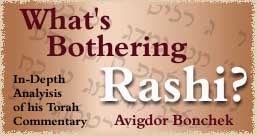

Back to this week's parsha | Previous Issues
Parashas ShemosRashi’s use of midrash instead of p’shat must be understood Exodus 2:2 The woman conceived and bore a son. She saw that he was good and she kept him hidden for three months. That he was good: Rashi: When he was born the whole house was filled with light.
Questioning Rashi Certainly this isn’t the simple p’shat of the words “that he was good.” Why does Rashi offer this midrashic interpretation? Is something about these words bothering him? Hint: Read the whole verse. What might be bothering Rashi? Your Answer:
What Is Bothering Rashi? An Answer: If we take the verse at face value, it says in effect: The woman saw that her son was good and therefore she decided to try to save him, by hiding him. The obvious question is: Wouldn’t any mother want to save her son ? Isn’t any child “good” enough to try to save from certain death? Therefore Rashi rejects the “simple meaning.” How does the midrashic interpretation answer the question? Your Answer:
Understanding Rashi An Answer: A reason had to be found why Moses’ mother tried to save him when no other Jewish mother did likewise for their sons. By citing the midrash that some supernatural sign was evident at Moses’ birth - the house was filled with light - she realized that perhaps her efforts to save him would be successful. This, then, is the cause of (and connection with) the following words “and she hid him for three months.” She saw that he was good (i.e. the light emmanating from him) and therefore decided to hide him. A common rule for interpreting the words of the Torah according to p’shat is that when two facts are brought together in the same sentence they are probably connected in some way, either in a causal or in an associative way. In our sentence the two parts are connected in a causal way: “She saw that he was good (supernatural light)” and therefore “she hid him.” Understanding the Midrash Rashi’s comment is based on a midrash and is not what we would consider straight p’shat. Midrash has its own characteristic methods of interpretation. A common one is the Gezera Shaveh (word association). In our verse we have, “And she saw that he was good ( “Ki tov”) . These same words “Ki tov” are found elsewhere in the Torah. Can you think where? Your Answer:
Answer: In Genesis 1:4 where it says: And G-d saw the light that it was good; and G-d separated between the light and the darkness. Here we see that the very same words, “Ki tov”, that are used to describe the child Moses, are also used to describe the light at Creation. This word association is the basis for the midrashic interpretation that at Moses’ birth there was a supernatural light in the house. Back to this week's parsha | Previous Issues
|